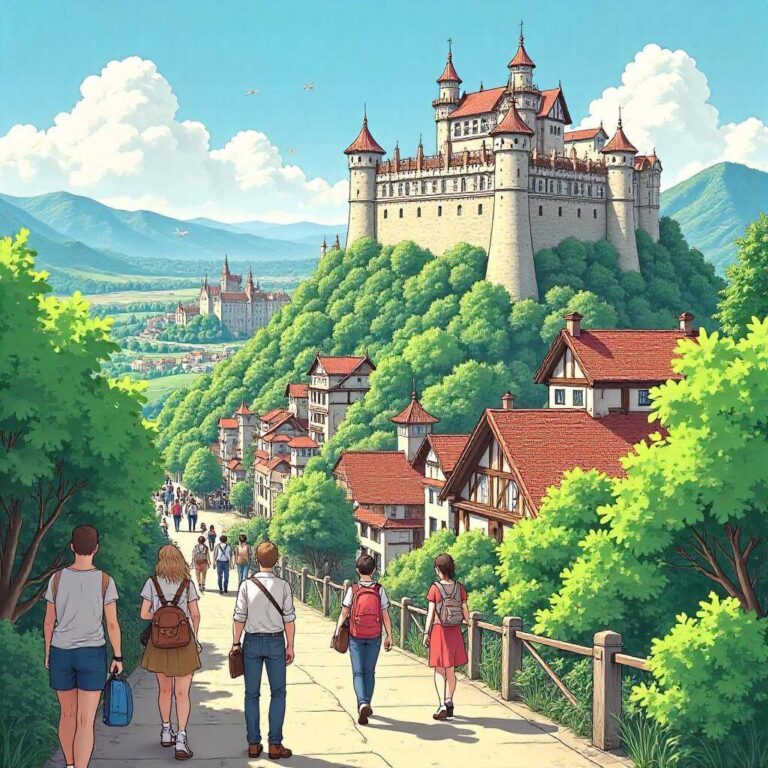Exploring Matsue Castle, Iwami Ginzan, Izumo Taisha, Tsuwano Castle Ruins, and Hagi Castle Town by Public Transport Japan is a country where history, culture, and stunning natural beauty intersect at every turn. If you’re planning to explore the beautiful landscapes,
historical sites, and cultural treasures of the Chugoku region, specifically Matsue, Iwami Ginzan, Izumo Taisha, Tsuwano Castle Ruins, and Hagi Castle Town, you can do so conveniently by public transport. This travel guide will provide you with practical logistics, cultural insights, insider tips, budget considerations, timing recommendations, and step-by-step planning advice to ensure your trip is smooth and enjoyable. Travel Plan Overview This itinerary is designed for five days, allowing you to visit each destination in a relaxed manner while using public transportation. Although getting around without a car may present some challenges, the experience of using Japan’s efficient public transport system is rewarding in itself. Day 1: Matsue Arrival in Matsue Matsue, often referred to as the “City of Water,” is known for its picturesque landscape formed by Lake Shinji and the surrounding rivers. Arriving here is easy via the Sanin Line from Okayama or Hiroshima. Visiting Matsue Castle Matsue Castle, one of Japan’s few remaining original castles, is a must-see. Built in 1611, it’s a stunning example of Japanese feudal architecture. Spend a few hours exploring the castle’s interior, which houses a museum detailing the castle’s history and view the scenic landscape from the top floor. Insider Tip: Early mornings are the best time to visit to avoid crowds. Don’t forget to take your time at the castle grounds, which are particularly beautiful during cherry blossom season in April. Relaxing in Matsue Onsen After a day of exploration, unwind at a local onsen. Matsue has several onsens that range from traditional ryokan-style to modern facilities. Try Tamatsukuri Onsen, known for its healing waters and tranquil atmosphere. Budget Consideration: Entry to Matsue Castle is about 600 yen, while an onsen visit can range from 500-1500 yen depending on the facility. Day 2: Iwami Ginzan Getting to Iwami Ginzan The next morning, take a bus from Matsue to Iwami Ginzan (approximately 1.5 hours). The bus ride is scenic, offering views of the countryside. Exploring the UNESCO World Heritage Site Iwami Ginzan is a UNESCO World Heritage Site recognized for its rich history as a silver mine during the Edo period. Visit the mine’s museum to learn about its historical significance and the mining process. Spend time walking through the old streets lined with traditional wooden buildings and charming shops. Hidden Gem: Don’t miss the short hike to the nearby trails that lead to stunning viewpoints overlooking the valley. The trail is well-maintained and offers a peaceful escape into nature. Dining in Iwami Ginzan Enjoy lunch in one of the local restaurants. Local specialties include “soba” noodles and various seafood dishes, reflecting the area’s rich maritime culture. Budget Consideration: Entrance to the mine museum is around 500 yen, and meals can range from 1,000 to 2,500 yen depending on your choice of restaurant. Day 3: Izumo Taisha Traveling to Izumo Taisha On Day 3, take a train from Matsue to Izumo City (approximately 30 minutes). The trains are frequent and comfortable. Discovering Izumo Taisha Shrine Izumo Taisha is one of Japan’s oldest and most important Shinto shrines, dedicated to Okuninushi, the deity of marriage. The shrine is known for its grand architecture and spiritual atmosphere. Spend time exploring the grounds, including the sacred trees and the beautiful entrance gates. Cultural Insight: If you’re interested in traditional Shinto practices, consider participating in a Shinto ceremony if available during your visit. It’s a unique way to understand Japanese spirituality. Evening in Izumo In the evening, try local Izumo soba for dinner. This dish is different from other soba noodles found in Japan and is a regional specialty. Budget Consideration: Entrance to Izumo Taisha is free, and meals can range from 800 to 2,000 yen. Day 4: Tsuwano Castle Ruins To Tsuwano On Day 4, head to Tsuwano by taking a train from Izumo City (about 1 hour). The journey is beautiful, taking you through rural landscapes. Exploring Tsuwano Castle Ruins Once you arrive, visit the Tsuwano Castle Ruins, which offer stunning views of the surrounding mountains. The area is well-preserved, and you can explore the castle’s remnants while enjoying a leisurely walk through the town, adorned with traditional houses and picturesque scenery. Insider Tip: Don’t miss the Kiyomizu-dera Temple, located nearby, which offers a serene atmosphere and beautiful views. Strolling Around Tsuwano Take time to explore Tsuwano’s quaint streets, lined with shops selling local crafts and delicious snacks. Be sure to try “Tsuwano’s sweet potato cake,” a local delicacy. Budget Consideration: Entrance to the castle ruins is free, and the cost for meals and snacks can range from 1,000 to 2,000 yen. Day 5: Hagi Castle Town Journey to Hagi On your final day, take a train from Tsuwano to Hagi (approximately 1.5 hours). Hagi is renowned for its well-preserved samurai residences and historical sites. Exploring Hagi Castle Town Begin your exploration at Hagi Castle Ruins. While the castle itself is in ruins, the surrounding park is beautiful and perfect for a stroll. Visit the samurai residences, many of which have been turned into museums showcasing the lifestyle of samurai families. Cultural Insight: Hagi is also famous for its pottery. Consider visiting a local pottery shop where you can watch artisans at work and even try your hand at pottery-making. Enjoying Local Cuisine As your trip comes to an end, treat yourself to some fresh seafood along the coast. Hagi is known for its quality fish dishes, so make sure to indulge! Budget Consideration: Entrance to the castle ruins is free, and dining experiences can range from 1,200 to 3,000 yen depending on your choice of restaurant. Conclusion Traveling by public transport from Matsue to Iwami Ginzan, Izumo Taisha, Tsuwano, and Hagi is a fantastic way to immerse yourself in the rich culture and stunning landscapes of Japan. While public transport may come with its challenges, the journey becomes a part of the adventure. Final Tips 1. Purchase a Rail Pass: Consider buying the Sanin Area Pass if you plan to use trains frequently. It offers unlimited travel for a fixed period and can save you money. 2. Plan Your Transport: Make use of apps like Hyperdia or Google Maps to plan your train and bus routes efficiently. 3. Pack Light: Navigating public transport with heavy luggage can be cumbersome. A small backpack for daily essentials will make your journey smoother. 4. Respect Cultural Sites: Always be mindful of the rules at temples and shrines. Photography may not be allowed in certain areas, and it’s important to show respect. 5. Stay Hydrated and Snack Smart: Carry a water bottle and some snacks with you for long travel days, as convenience stores may not always be nearby. Embark on your journey to discover the hidden gems of Japan, and create unforgettable memories in this enchanting land!

Posted inJapan Trip


